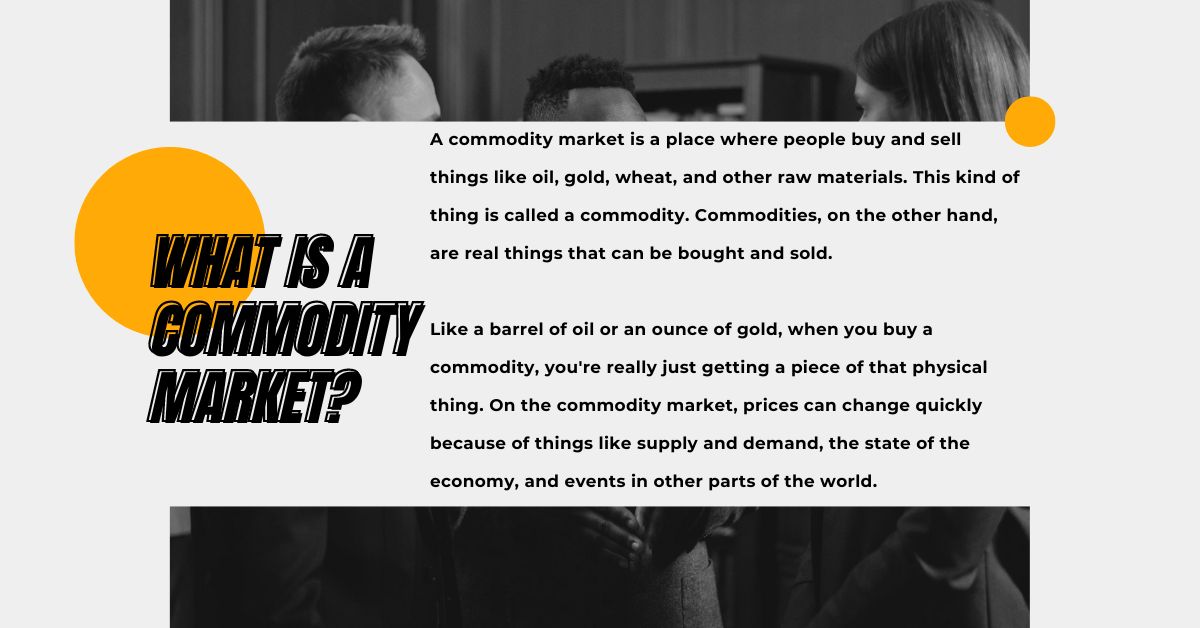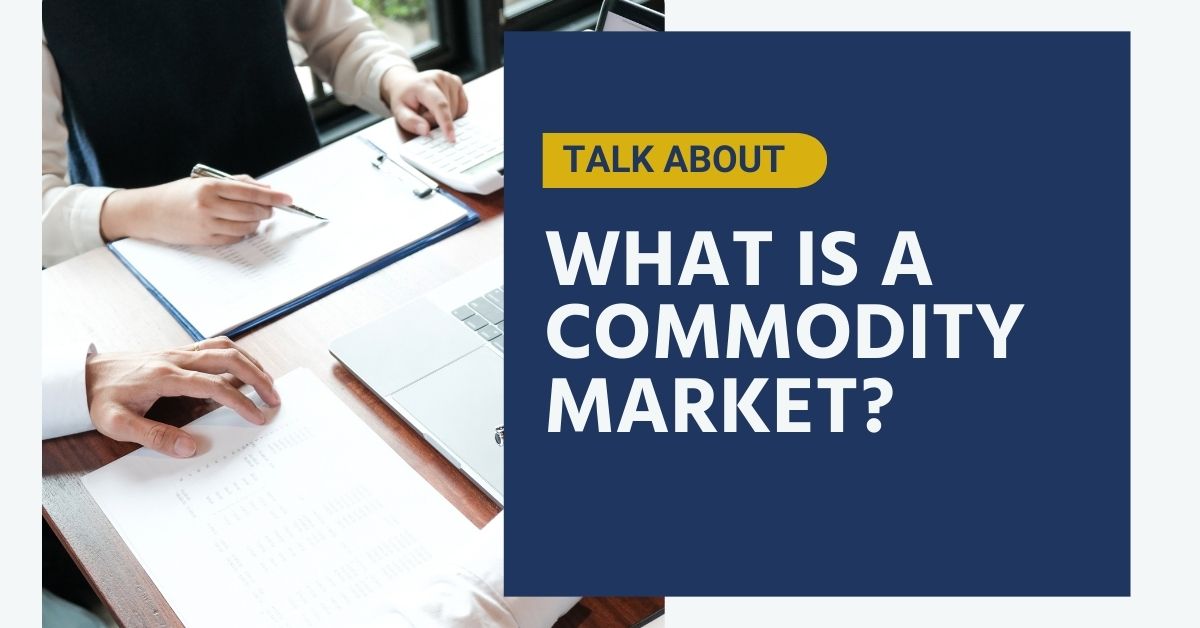It’s not just the stock market where you can trade money. The commodities market, where people buy and sell physical goods like bullion, metals, and other commodities, is another popular market.
We will talk about the market for trading commodities in this article. We’ll also talk about the pros, cons, and different kinds of commodity contracts.
What is Commodity Market?

A commodity market is a place where people buy and sell things like oil, gold, wheat, and other raw materials. We refer to this type of item as a commodity. On the other hand, commodities are tangible items that are available for purchase and sale.
Like a barrel of oil or an ounce of gold, when you buy a commodity, you’re really just getting a piece of that physical thing. On the commodity market, prices can change quickly because of things like supply and demand, the state of the economy, and events in other parts of the world.
Types of Commodity Markets
There are two main types of commodity markets:
- Spot Market: This marketplace facilitates the immediate purchase and sale of commodities. In other words, if you buy a barrel of oil on the spot market today, you expect to get it right away.
- The Futures Market is the marketplace where individuals purchase and sell contracts for the future delivery of commodities. To give you an idea, you could buy a futures contract for three months’ worth of oil. In this case, you agree to buy the oil at a certain price in the future, no matter what the spot price is at that time.
How Commodity Markets Work?
A commodity market functions similarly to a typical store. Let’s say you want to get some bread. You decide if you want to buy it after going to the shop and seeing how much it costs. At a commodity market, people don’t buy and sell bread. Instead, they buy and sell things like cash, oil, and wheat.
A good’s price depends on how much people need and want it. Low demand indicates a lack of interest in purchasing a good, resulting in its abundance. This means that the price will be low. If there isn’t much of a good on the market (low supply) but a lot of people want to buy it (high demand), the price will be high.
History of Commodity Markets
Markets for commodities have been around for hundreds of years. People who study history say they may have started in Mesopotamia, where farmers would sell crops like wheat and barley. Over time, these markets changed and grew to include metals, valuable stones, livestock, and other goods.
During the Middle Ages, guilds or wealthy families often ran the shops for goods. This caused prices to be high and competition to be weak. But as trade lines opened up and ways to get around got better, these guilds lost some of their power.
The development of the modern product market began in the 1800s. As futures markets grew in places like Chicago and London, traders were able to buy and sell goods that would be delivered in the future. This lower risk kept prices stable.
Commodity markets became more important over the course of the 20th century, especially as the world economy became more linked. They now have a big impact on the world economy and can change the price of anything from food to energy.
Why Invest in the Commodity Market?
There are several possible benefits to investing in the commodity market:
- Investing in commodities can help spread out your money. They don’t always move the same way as stocks and bonds, so they can help protect your money when the market goes down.
- If you want to protect yourself from inflation, commodities can be a good choice. Things usually become more valuable when their prices go up.
- Since commodities are sold worldwide, you can exploit foreign markets.
- Investments in commodities can be lucrative, especially when the economy is strong or other countries are struggling.
But buying commodities comes with risks, like the chance of big losses and prices that go up and down.
How are Prices Determined in Commodities Exchange?
How much people need and want a product determines its price on the commodity market. If supply doesn’t meet demand, commodity prices will rise. If there is low demand and high supply, on the other hand, the price will go down.
Several factors can influence supply and demand, including:
- Economic conditions: If the economy is doing well, people may be more likely to buy commodities, which can increase demand and prices.
- Weather: Weather can affect the production of some commodities, such as agricultural products. For example, a drought can reduce the supply of wheat, which can increase its price.
- Geopolitical events: Events like wars or natural disasters can disrupt the supply of commodities, which can also affect prices.
Overall, the price of a commodity is a reflection of the balance between supply and demand in the market.
Relationship Between Stock Market and Commodity Market
There are several connections between the stock market and the commodity market.
Direct Impact:
- Company Performance: Many companies on the stock market are involved in the production or trading of commodities. As an example, think about oil companies, mining companies, and farming businesses. The prices of the commodities these companies deal with affect their performance and stock value. As commodity prices rise, these companies perform better and their stock prices may rise. On the other hand, when commodity prices go down, it can hurt their success and stock prices.
- Commodity prices can impact consumer spending, which in turn affects the stock market. A rise in commodity prices can result in increased costs for consumers, which can reduce their disposable income. This has the potential to influence consumer spending on products and services, which in turn can affect the performance of companies in a variety of sectors and, as a result, the stock market.
Indirect Impact:
- Economic indicators: Both the stock market and the commodity market are able to compare the state of the economy as a whole. For example, an increase in commodity prices may indicate an increase in inflation and economic activity. This has the potential to impact stock prices and investor sentiment.
- Interest rates: Most of the time, central banks use interest rates to manage the economy. It might cost more to borrow money if interest rates go up. This could slow down economic growth and have an effect on both the stock market and the trade market.
- Investor sentiment: How the stock market and commodity markets perform can impact how investors feel. Both markets doing well may make investors feel better about the economy and more willing to invest. On the other hand, a drop in both markets can make investors less optimistic and cause them to spend less.
To sum up, there are both direct and indirect links between the stock market and the commodity market. The actions of one market can significantly impact the other. Investors can make better decisions about their stocks if they understand these connections.
Benefits and limitations of Commodity Market
| Benefit | Limitation |
|---|---|
| Diversification: Commodities can help diversify an investment portfolio, reducing risk. | Volatility: Commodity prices can be highly volatile, leading to significant losses. |
| Inflation Hedge: Commodities can be a good hedge against inflation, as their prices often rise with inflation. | Storage Costs: Physical commodities can incur storage and transportation costs. |
| Global Exposure: The global trading of commodities presents opportunities for international investment. | Speculative Trading: Commodity markets can be susceptible to speculative trading, driving prices away from their fundamental values. |
| Potential for High Returns: Commodities can offer the potential for high returns, especially during periods of economic growth or geopolitical instability. | Lack of Dividends: Unlike stocks, commodities typically do not pay dividends. |
| Real Asset: Commodities represent tangible assets, which can provide a sense of security for some investors. | Complexity: Understanding the dynamics of commodity markets can be complex, requiring specialized knowledge. |

